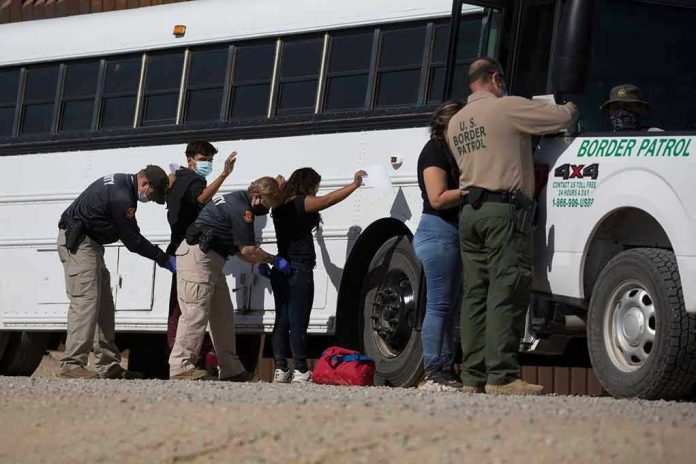
When a government accuses the press of deception over what the nation sees at its borders, the real battle is for the very trust that holds a democracy together.
Story Snapshot
- DHS publicly rebuked The Washington Post for its report on misleading immigration operation videos
- Controversy exposes deep rifts between government messaging and media accountability
- Public trust in both federal agencies and journalism faces renewed scrutiny
- Potential reforms in government communications and congressional oversight loom large
Federal Agencies Clash With Press Over Immigration Narratives
The Department of Homeland Security’s furious response to The Washington Post’s investigative report was not just a press release—it was a shot across the bow in a high-stakes fight over who controls the American immigration story. The Post’s mid-October exposé revealed that several videos distributed by DHS and its enforcement arms, Customs and Border Protection and ICE, had been edited or released selectively. The implication: these visuals were shaping public perception in ways that may not have matched reality, especially as immigration debates reached a fever pitch. The DHS, in turn, denounced the allegations within hours, calling the report “inaccurate and irresponsible,” and igniting a media and political firestorm that refuses to die down.
Public reaction was swift and polarized. Advocacy groups and opposition politicians demanded oversight, while some supporters of the agencies insisted that operational security justified holding back the full truth. The unresolved question: How much context, editing, or omission turns official footage into manipulation? As the controversy stretched into its second week, the country’s leading newsrooms and congressional offices scrambled to determine whether this was isolated government spin or a symptom of an entrenched culture of “strategic communication” designed to command the national conversation.
History of Contested Narratives and Misinformation
Government agencies have long wielded images and footage as tools in the information wars, but the digital age has made that power both more potent and more perilous. DHS, CBP, and ICE’s use of video to document—and sometimes dramatize—enforcement actions is not new. Yet, since 2021, mounting migration at the southern border and a divided electorate have made every image a flashpoint. Previous incidents—like the infamous 2021 CBP horseback patrol images or ICE raid videos from 2019 through 2022—set the stage for today’s accusations. Each controversy left a residue of skepticism among both the media and the public, fueling a climate where every pixel of government-released footage is suspect until proven genuine.
Media organizations, under pressure to contextualize and verify, now treat each government press release almost as a legal deposition. Advocacy groups argue that, with lives and rights on the line, accuracy is non-negotiable. The result is a perpetual standoff: government agencies want to assure the public of their vigilance, but journalists increasingly see themselves as the last line of defense against narrative manipulation.
Key Stakeholders and Power Struggles
This confrontation draws in a formidable cast: DHS and its communication strategists, CBP and ICE public affairs teams, The Washington Post’s investigative unit, immigrant advocacy groups, and congressional watchdogs. The motivations are clear—DHS seeks to defend its mission and maintain public confidence, while the Post aims to uphold its watchdog role. But the power dynamics are shifting. Federal agencies wield vast resources and control over information flow, yet their authority is checked by the media’s ability to influence public sentiment and, by extension, policy. Congressional leaders, sensing the political opportunity, have called for hearings and oversight, eager to either rein in agency excess or defend national security prerogatives, depending on their political bent.
In this volatile environment, even DHS insiders are divided. Some former officials defend the agency’s need for discretion in the name of safety; others warn that overzealous messaging can backfire, eroding the very trust needed to fulfill the agency’s mission. Media ethics experts and academic commentators warn that blurring the line between public information and propaganda endangers democratic accountability at its core.
Potential Impacts: Trust, Reform, and the Road Ahead
The short-term fallout is clear: public trust in DHS and federal communications has taken a hit, while the media’s role as a gatekeeper faces renewed scrutiny. Immigrant communities, already vulnerable to policy swings and media narratives, are left with heightened anxiety as official stories diverge. Calls for transparency and independent review grow louder, with some advocacy groups demanding that all enforcement footage undergo external vetting before release.
The long-term consequences could be historic. Congressional hearings may drive reforms in how government agencies release and contextualize operational footage. Media outlets will likely intensify their fact-checking and verification procedures. Above all, the American public, caught between official reassurances and investigative skepticism, faces a future where the authenticity of what they see is never taken for granted. The battle for the border’s narrative is not just about immigration—it is about who decides what America believes, and why.
Sources:
The Washington Post, October 2025
DHS Press Release, October 2025
Columbia Journalism Review, 2024






